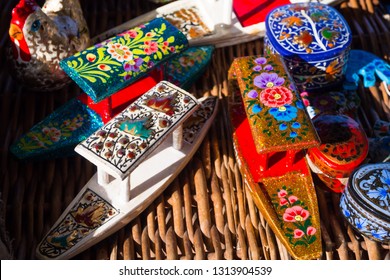Nestled within the folds of the majestic Himalayas, Kashmir has long been known not only for its breath-taking landscapes but also for its exquisite and time-honoured handicrafts. The valley’s legacy of handmade artistry is deeply embedded in its cultural identity, passed through generations as both livelihood and living heritage. From luxurious Pashmina shawls to the intricate woodwork of walnut trees, Kashmiri handicrafts narrate the story of a people deeply rooted in tradition, yet enduring through the lens of modern challenges.
The craftsmanship of Kashmir dates back to ancient times with artisans working under royal patronage in the courts of Hindu, Buddhist and later Muslim rulers. During the 14th century, Kashmir saw a significant flourishing of art forms, mainly under the influence of Persian artisans who migrated to the valley during the reign of Sultan Zain-ul-Abidin, fondly remembered as Budshah. This era marked the refinement of several crafts, including carpet weaving, papier mache and embroidery which still form the foundation of Kashmiri craft today.Among the most iconic symbols of Kashmiri art is the Pashmina shawl, soft, warm and woven from the fine undercoat of the Changthangi goat found in Ladakh. The skill of hand-weaving these shawls lies in the intricate craftsmanship passed down through families of artisans. Embellished with elaborate Sozni or Tilla embroidery, each piece becomes not just a garment but a canvas of cultural expression. These shawls were once traded along the Silk Road and were admired by emperors and aristocrats.
The abundant walnut trees of Kashmir have given rise to a rich tradition of wood carving that is unrivalled in detail and quality. From intricately carved panels to fine furniture and decorative items, the walnut wood industry of Kashmir is both a utility and an art. Artisans often spend months on a single piece, combining patience and passion into creations that reflect motifs of chinar leaves, paisleys and floral vines.A vibrant and visually rich art form, papier-mache in Kashmir originated from Persia and evolved into a uniquely local style. The craft involves moulding pulped paper into items like vases, boxes and trays which are then hand-painted with intricate designs using natural pigments and lacquered for durability. These designs often incorporate elements from Kashmiri nature, flowers, birds and idyllic scenes, all rendered in brilliant colours.
Despite its rich heritage, the handicraft industry of Kashmir faces multiple challenges. From the declining number of artisans due to low returns and lack of institutional support to the influx of machine-made replicas that threaten authenticity, the survival of these traditional crafts hangs in the balance. Yet, through governmental schemes, despite international exhibitions and revivalist efforts by NGOs and design collectives, the resilience of the Kashmiri artisan spirit remains unbroken.Efforts to revive handicrafts include skill training centres, GI tagging for authenticity and digital platforms promoting artisans globally. Kashmiri shawls and carpets continue to find a place in global fashion and decor while young designers and entrepreneurs bring contemporary relevance to ancient crafts.
Kashmir’s handicrafts are more than products, they are the embodiment of centuries of artistic evolution, endurance and a deep-rooted cultural consciousness. In every thread woven, every wood chiselled and every brushstroke applied, lies the spirit of Kashmir, timeless, detailed and resilient. Preserving these crafts is not just a nod to tradition but a celebration of Kashmiri identity in the face of change.


